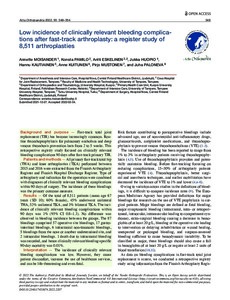Low incidence of clinically relevant bleeding complications after fast-track arthroplasty: a register study of 8,511 arthroplasties
Moisander Annette; Pamilo Konsta; Eskelinen Antti; Huopio Jukka; Kautiainen Hannu; Kuitunen Anne; Mustonen Pirjo; Paloneva Juha
https://urn.fi/URN:NBN:fi-fe2022081154652
Tiivistelmä
Background and purpose: Fast-track total joint replacement (TJR) has become increasingly common. Routine thromboprophylaxis for pulmonary embolism and deep venous thrombosis prevention lasts from 2 to 5 weeks. This retrospective registry study focused on clinically relevant bleeding complications 90 days after fast-track primary TJR.
Patients and methods: All primary fast-track total hip (THA) and knee arthroplasties (TKA) performed between 2015 and 2016 were extracted from the Finnish Arthroplasty Register and Finnish Hospital Discharge Register. Type of arthroplasty and indication for the operation were combined with diagnoses of clinically relevant bleeding complications within 90 days of surgery. The incidence of these bleedings was the primary outcome measure.
Results: Of the total of 8,511 patients (mean age 67 years (SD 10); 60% female), 45% underwent unilateral THA, 52% unilateral TKA, and 3% bilateral TKA. The incidence of clinically relevant bleeding complications within 90 days was 1% (95% CI 0.8–1.3). No difference was
observed in bleeding incidence between the groups. The 87 bleedings comprised 57 operative site bleedings, 17 gastrointestinal
bleedings, 6 intracranial non-traumatic bleedings, 5 bleedings from the nose or another undetermined site, and 2 intraocular bleedings. 1 death due to intracranial bleeding was recorded, and hence clinically relevant bleeding-specific 90-day mortality was 0.01%.
Interpretation: The incidence of clinically relevant bleeding complications was low. However, they cause patient discomfort, increase the use of healthcare services, and can be life-threatening and even fatal.
Kokoelmat
- Rinnakkaistallenteet [27093]
